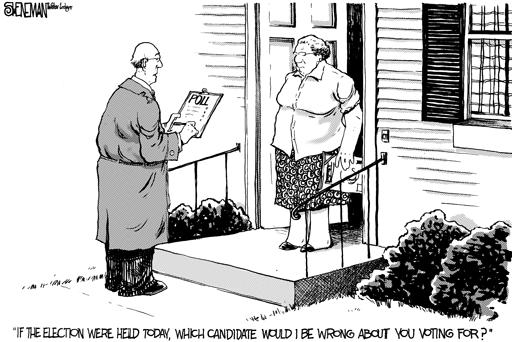
Five tips that will help you better understand political polling during an election year:
- Who conducted the poll? Put a lot of faith into polls conducted by these firms: Gallup, Ipsos, Public Policy Polling, CNN, Washington Post, and ABC News. These organizations are usually not sponsored by political parties or candidates, which makes them more reliable.
- Disclosure of polling methodology: If a polling firm hasn’t disclosed how it received its results, then it should not be trusted. A polling firm must be able to explain how they received their numbers. For example, by explaining the methodology of the poll, you can figure out whether the respondents were reached by cell phone numbers or land line telephones. One can also discern how people were questioned, their party affiliation, and the dates contacted — these seemingly innocuous details are imperative in interpreting data. Senior citizens rarely use cell phones and thus usually cannot be contacted through surveys over cell phones. On the other hand, young people can be contacted easier though cell phones than land line telephones. By taking those groups of the electorate separately, you could skew polls in your favor. Example of this methodology from a recent NBC/WSJ poll conducted on 9/18/12: The full NBC/WSJ poll — which was taken of 900 registered voters (270 by cell phone) from Sept. 12-16 and which has an overall margin of error of plus-minus 3.3 percentage point.
- Is the wording of questions fair? Reputable polling organizations disclose the exact question they ask a respondent. Incorrect disclosure of the wording of questions can introduce bias and cause errors in polls.
- Identifying the difference between likely-voters and registered voters. During the course of a survey, respondents are asked questions such as their interest in the election, whether they are registered to vote, or whether they plan to vote. Based upon the answers to those questions, pollsters determine who likely voters are. For example, if they answer “yes” to whether they plan to vote, and if they answer “yes” to high interest in the election, they are known as likely voters. Just before the election, pollsters usually report results based upon a narrow set of voters who are called registered voters that appear to be the most likely to vote and who are already registered. Also, registered voters usually express high interest regarding whether they plan to vote. Likely voters are a wider poll of voters, and they are not as reliable as registered voters (who form a much smaller pool). Political pundits on T.V. usually put more emphasis on registered voters because they answered “yes” to most of the questions outlined above.
- How do you identify the mix of Democrats, Republicans, and Independents when asking questions? Pollsters never choose the same sample of Democrats, Republicans, and Independents. Instead, they take random selections of people, and gauge who is most likely to vote. Also, pollsters who assume that party identification doesn’t shift over time can be wrong because there have been enormous partisan fluctuations since 2006. Therefore, always understand that most polls usually oversample some parties.



